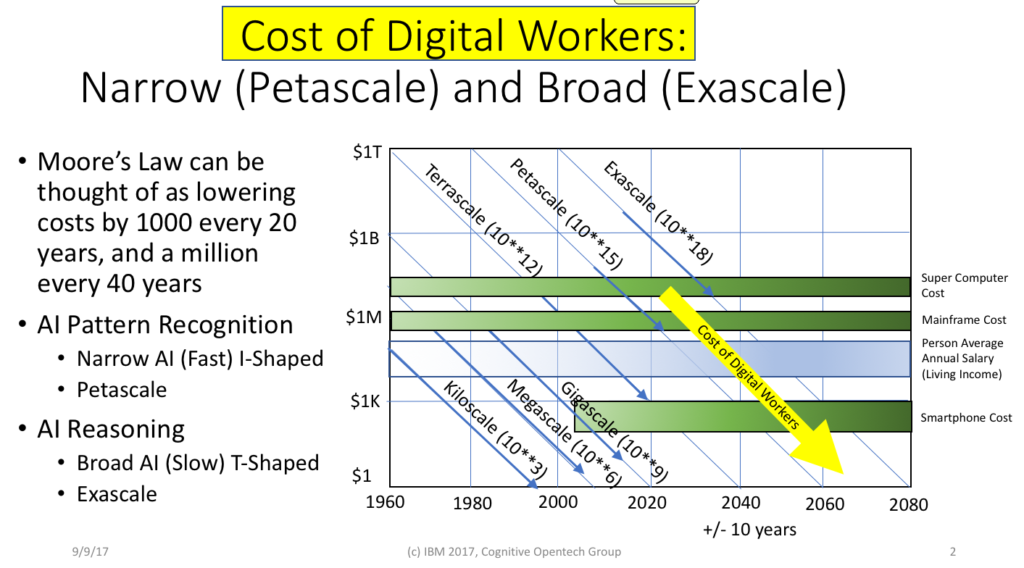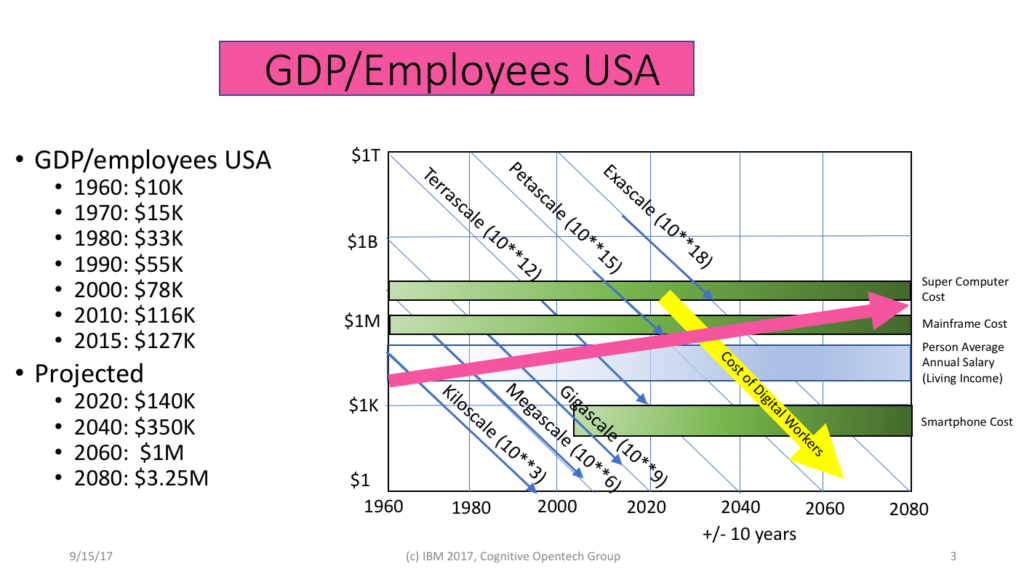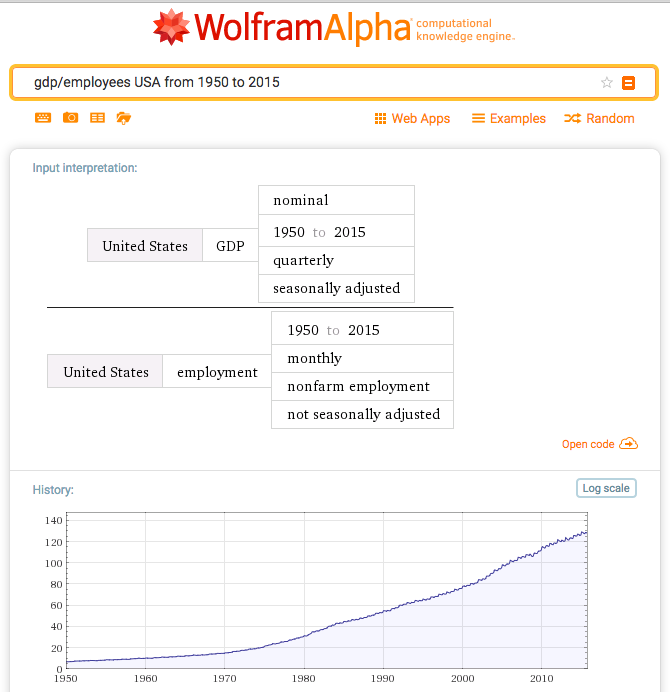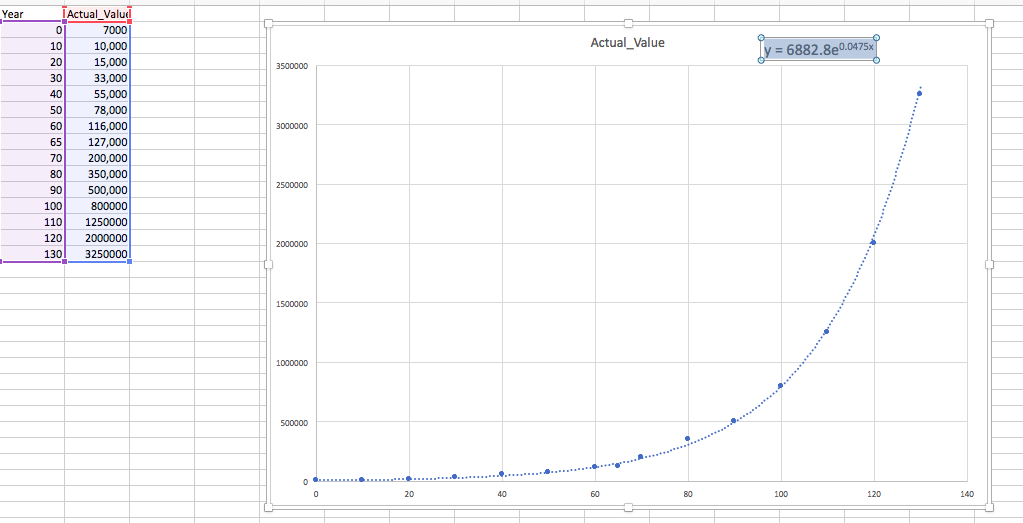Imagination challenge: Consider quantifying and graphing the decreasing cost of digital workers due to Moore’s Law, and increasing GDP/Employees USA from 1960 to 2080 (projected).
A narrow digital worker will cost about a million dollars by 2025, and require a petascale computational system. The same digital worker will cost about a thousand dollars by 2045, and about $1 by 2065.
A digital worker that can drive a car for example, or transcribe medical records, or provide the services of a well-trained retail clerk. The incremental cost of additional digital workers who perform the same task will be much smaller. So areas of specialization in business and society that need narrow biological workers (people and animals) in large quantities will be have digital worker alternatives at dropping costs.
A broad digital worker (capable of doing anything any narrow digital worker can do) will cost a million dollars by 2045, a thousand dollars by 2065, and about $1 by 2085, and require an exascale computational system.
Feedback welcome on diagrams below, which explore thinking about smarter/wiser service systems with digital workers. Decreasing cost of digital workers due to Moore’s Law, and increasing GDP/Employees USA from 1960 to 2080 (projected)

Digital Workers



Full presentation here:
https://www.slideshare.net/spohrer/cost-of-dw-20170909-v18
… and please read more about cognitive opentech here:
https://service-science.info/archives/4629
Also see: https://arxiv.org/pdf/1705.08807.pdf
K. Grace, J. Salvatier, A. Dafoe, B. Zhang, and O. Evans, “When Will AI Exceed Human Performance? Evidence from AI Experts,”ArXiv e-prints , May 2017.
Acknowledgements
Thanks to Marius Ciortea for “revenue per employee” idea – I could only find gdp/employees as an approximation, but will keep looking for data. Thanks to Dan Gruhl and Daniel Pakkala for help with Moore’s Law and decreasing “cost of digital workers” data. Horst Simon sent me some power information for super compters, hope to get into next version.
Reading Recommendation (via Francesca Rossi and Susan Malaika)
Tegmark’s Life 3.0
https://www.amazon.com/Life-3-0-Being-Artificial-Intelligence/dp/1101946598
https://www.theguardian.com/books/2017/sep/22/life-30-max-tegmark-review
From review by Harari’s Guardian review:
In the 21st century, AI will open up an even wider spectrum of possibilities. Deciding which of these to realise may well be the most important choice humankind will have to make in the coming decades. This choice is not a matter of engineering or science. It is a matter of politics.
Max Tegmark’s Life 3.0 tries to rectify the situation. Written in an accessible and engaging style, and aimed at the general public, the book offers a political and philosophical map of the promises and perils of the AI revolution. Instead of pushing any one agenda or prediction, Tegmark seeks to cover as much ground as possible, reviewing a wide variety of scenarios concerning the impact of AI on the job market, warfare and political systems.
Once an algorithm knows you better than you know yourself, institutions such as democratic elections and free markets become obsolete, and authority shifts from humans to algorithms. Instead of fearing assassin robots that try to terminate us, we should be concerned about hordes of bots who know how to press our emotional buttons better than our mother, and use this uncanny ability to try to sell us something. It might be apocalypse by shopping.
Though Tegmark is probably correct in taking things to this cosmic level, I fear that many, if not most, of his prospective readers will not follow him there. Our political systems, and indeed our individual minds, are just not built to think on such a scale. Current political mechanisms barely manage to make decisions on the scale of decades – how can they make decisions on the scale of millennia?